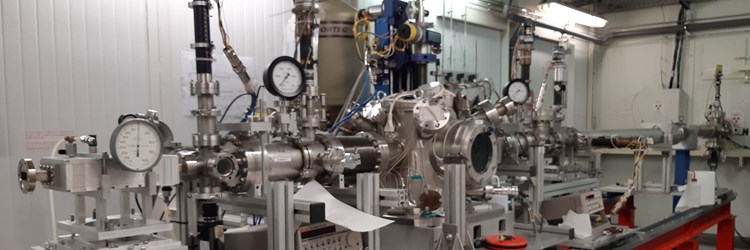

Linea Italiana per la Spettroscopia d'Assorbimento - is a beamline operative at the European Synchrotron Radiation Facility that is dedicated to X-ray absorption spectroscopy
The LISA beamline is operative at the European Synchrotron Radiation Facility and it is dedicated to X-ray absorption spectroscopy and related techniques.
The beamline consists in an optic hutch where the x-ray beam is prepared for the experiments (monochromatization and focusing) and in 2 endstations, one with the focused beam (typical dimensions 150*150 m) and the other with a wide, homogeneous beam. The energy range spans from 4 to about 90 keV and the typical flux is around 10 10 -10 11 ph/s. The endstations are equipped with vacuum chambers and different systems for sample treatment and signal detection. Efficient detectors for X-ray Fluorescence (two HP-Ge arrays and one SDD array) are used particularly adapted to the study of diluted materials (concentration limit ≈ 10 14 at/cm 2 ). Cryostats and cryo-ovens permit to carry out measurements from 10 K to 1000 K. A grazing incidence sample manipulator can be used for measurements in total reflection condition,
particularly useful for surface studies without UHV conditions. A pulsed diode laser (=400nm) synchronized with the machine Radio Frequency signal permits the realization of measurements in stroboscopic pump-probe mode. The beamline is fully open to users, with 1/3 of the beamtime allocated to ESRF and 2/3 of the beamtime allocated by a CNR committee. On average every year 400-500 shifts are dedicated to Users for 25-30 experiments with an outcome of about 30 publications.
Software:
The beamline staff has realized all the software for the data acquisition with Graphic User Interfaces for an easier interaction with the user and various routines for data reduction. The LISA web site includes a page with several utilities for the users (ion chamber optimization, flux
calculation, ..). For the analysis of XAS data in total reflection mode we had developed (and currently use) the code “CARD”.
Instrumentation:
The design of LISA in terms of conceptual design, x-ray tracing and optical
optimization, technical design (parameters and technical specifications for the call for tender) has been completely carried out by the group. Instruments for data collection (XEOL spectrometer, grazing incidence manipulator, multisample Total Electron Yield detector) have been realized by the staff.
The research activity of the LISA group is concentrated on one side on the development of the beamline and novel methods of data collection and analysis. On the other hand each of the scientist of the group is active on a personal scientific topic.
About the first target activity we have developed instrumentation for surface XAS data collection (ReflEXAFS and Total Electron Yield methods), for X-ray Excited Optical Emission (XEOL) and apparata for stroboscopic pump and probe experiments.
On the data analysis side the group has developed a software for RefleXAFS data analysis (CARD) and methods for ab-initio simulation of EXAFS spectra via MD-DFT.
Concerning the scientific activities the group is active in the study of novel materials for microelectronics, with particular attention to materials for non-volatile memory (NVM) technology, environmental studies on metals in soils and airborne particulate, contaminants in soils and plants, dopants in systems with high electronic correlations.
In all cases X-ray Absorption Spectroscopy is the basic investigation technique to determine the local structure around chosen atomic species and eventually link the local parameters to macroscopic properties (namely bonds in glasses and relationship with stability and data-retain capability in NVMs, incorporation site of contaminants in soils related to with the lisciviation tendency, local structure in dopants and physical properties of ferromagnets/superconductors).
National:
International: